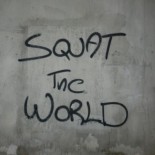Experimental Geographies
"There is tenderness only in the coarsest demand: that no-one shall go hungry any more" – Theodor Adorno, Minima Moralia (1974: 156)
Gängeviertel in Hamburg: One-Year Anniversary
I’ve just returned from a trip to Hamburg where I was conducting some research in the archives of the Hamburg Instiut für Sozialforschung. The archive contains a wealth of information relating to protest cultures and social movements in (West) Germany and I was able to track down some valuable materials on the ‘pre-history’ of squatting in West Germany and Berlin. This included a few box files relating to the Ablassgesellschaft (1967-1969), a Hamburg commune of sorts. These materials were especially useful in tracking some of the more performative dimensions of communal living (though this is not to suggest that the development of the squatter movement can be straightforwardly linked to an earlier history of communes).
As I noted in an earlier post, debates about gentrification have gained considerable traction here in Germany. One of the key flash points over the past year or so has been an attempt by the City of Hamburg to promote a new development strategy for the city (Hamburg: City of Talent). The plan is based, in many respects, on the work of Richard Florida and places strategic emphasis on the role of a “creative class” (and particular forms of immaterial labour) in shaping future development in the city. Much of this is covered in an article in Der Spiegel which is worth reading. As the article suggests, this plan has not gone uncontested and a network of 29 groups in Hamburg have come together under the banner of “Recht auf der Stadt” (Right to the City) to protest against what they see as the further gentrification of the city.
The Gängeviertel has, in this context, become a key symbol for a new wave of protest in Hamburg. As a cluster of narrow streets and run-down brick buildings, the Gängeviertel is all that is left of an older working-class neighbourhood that once connected the port to the new town. The area had been purchased from the city by a Dutch company (Hanzevast). New offices and luxury expensive flats were planned while most of the historic quarter was to be demolished. The recent financial crisis delayed these plans and on August 22, 2009, the Gängeviertel was squatted by over 200 artists and activists with a view to preventing the wholesale destruction of the quarter. Over the past year, the squatters have transformed the neighbourhood into a vibrant community. “Komm in die Gänge” has become a main slogan for the squatters, a clever wordplay which means both “Come into the alleyways” and “Get things moving.”
And yet, rather than evict the squatters, the city adopted a strategy of negotiation and, more recently, elected to buy back the land from Hanzevast. The squatters were acutely aware that they did not wish to be seen as gentrifying ‘pioneers’ and quickly penned a “Not in our Name” manifesto setting out their opposition to the recent rebranding of the city. As I understand it, the status of the Gängeviertel remains under discussion. There is much more that could be said here about the way in which the German state has chosen to deal with squatting since the 1970s. For the moment, I want to pick up on a point that I made in an earlier post about criticisms that have been directed at anti-gentrifiers. It has been suggested that questions of social capital and ‘distinction’ have superseded concerns about the re-urbanization of capital and the economic effects of displacement and eviction that inevitably accompany gentrification. The squatters in the Gängeviertel are acutely aware of this and are at pains to position their ‘labour’ within the critical sightlines of recent debates surrounding alternative forms of urbanism and ‘rights to the city’. To demonize anti-gentrifying movements tout court as being irreducibly conservative runs therefore the risk of playing into the hands of gentrifiers and lends surreptitious weight to the very argument about the ‘creative city’ that so many groups are at pains to oppose. This particular point was something that I did not flag up in an earlier post and it is important to highlight the many contradictions that have come to characterize debates surrounding gentrification in German cities.
The Gängeviertel celebrates its one-year anniversary this weekend with a full programme of events. More details can be found here.
